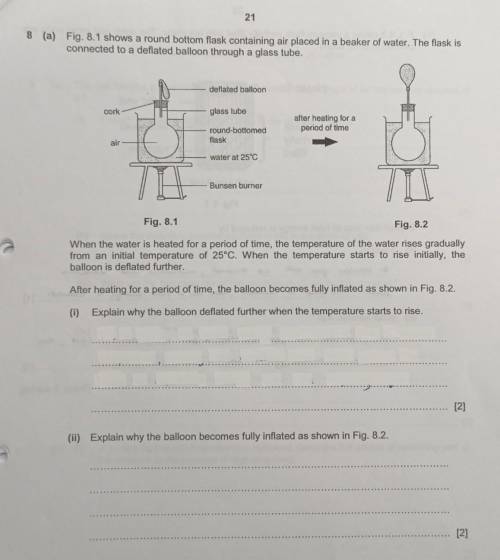
Physics, 20.09.2020 01:01 pencil8184
When the water is heated for a period of time, the temperature of the water rises gradually from an initial temperature of 25°C. When the temperature starts to rise initially, the balloon is deflated further. After heating for a period of time, the balloon becomes fully inflated as shown in Fig. 8.2.
(i) Explain why the balloon deflated further when the temperature starts to rise.
(ii) Explain why the balloon becomes fully inflated as shown in Fig. 8.2.


Answers: 1


Other questions on the subject: Physics

Physics, 22.06.2019 00:50, Amandarobersonn
While goofing off at the ice skating rink, a student takes off her shoes and places each of them on the ice. her friend, a hockey player, then shoots a hockey puck at each shoe. the first puck immediately comes to rest after it collides with the left shoe. the second puck rebounds after it collides with the right shoe. if each hockey puck has the same incoming speed, which shoe has greater speed after the collision? the right shoe. both shoes have the same speed. the left shoe.
Answers: 3


Physics, 22.06.2019 17:00, WorkingButNotReally
If a negatively charged particle is placed at rest in an electric potential field that increases in the positive x-direction, what will the particle do? a. accelerate in the positive x-direction b. remain at rest c. accelerate in the negative x-direction
Answers: 3

Physics, 22.06.2019 20:40, mathman783
Abasketball star covers 2.65 m horizontally in a jump to dunk the ball. his motion through space can be modeled precisely as that of a particle at his center of mass. his center of mass is at elevation 1.02 m when he leaves the floor. it reaches a maximum height of 1.90 m above the floor and is at elevation 0.910 m when he touches down again. (a) determine his time of flight (his "hang time"). (b) determine his horizontal velocity at the instant of takeoff. (c) determine his vertical velocity at the instant of takeoff. (d) determine his takeoff angle. (e) for comparison, determine the hang time of a whitetail deer making a jump with center-of-mass elevations yi = 1.20 m, ymax = 2.45 m, and yf = 0.750 m.
Answers: 1
You know the right answer?
When the water is heated for a period of time, the temperature of the water rises gradually from an...
Questions in other subjects:



English, 10.06.2020 17:57

English, 10.06.2020 17:57



Mathematics, 10.06.2020 17:57

Biology, 10.06.2020 17:57

Mathematics, 10.06.2020 17:57

History, 10.06.2020 17:57



